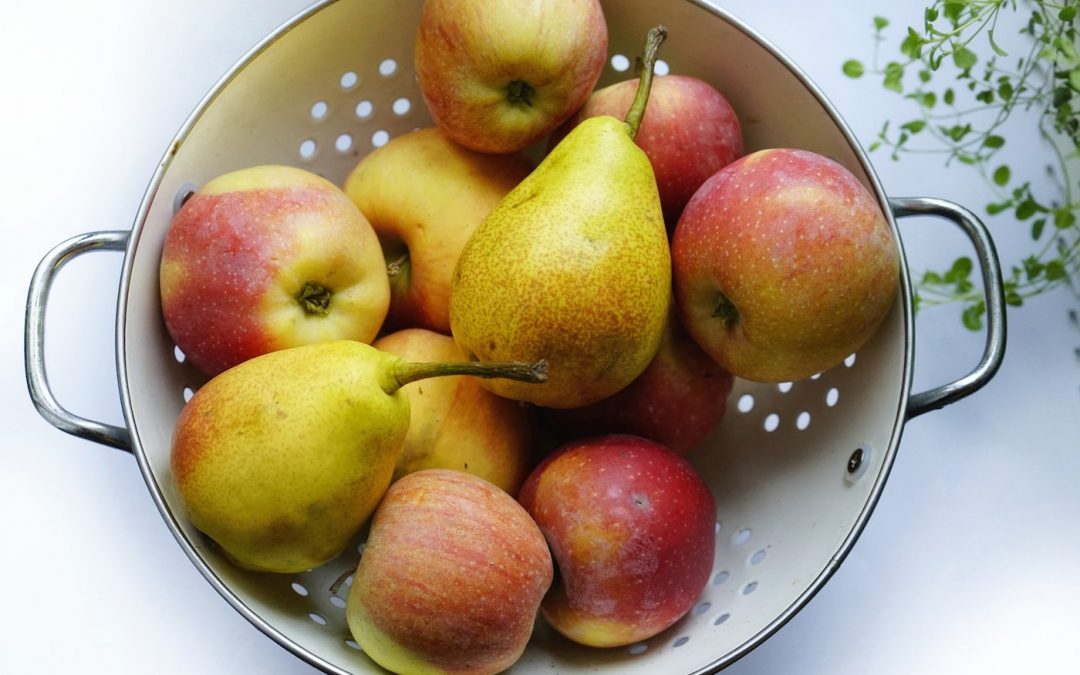6 health benefits of pears that will win you over
When I was younger, eating baked pears for dessert felt fancier than any fruit pie or cookie. And when the holidays rolled around and someone sent a box of Comice pears wrapped in gold foil? Talk about luxury.
Aside from special occasions, pears are just as worthy of your diet as apples, a fellow pome fruit. Comparisons often fly and while one grocery mainstay (cough, apples) tends to overshadow the other, the high-fiber, heart-healthy pear can stand on its own both in taste and nutritional value. Here are some health benefits of pears that will have you saying “A pear a day keeps the doctor away” at first bite.
What are the biggest health benefits of pairs?
Bosc, Bartlett, Red Anjou, oh my! Does it matter which kind you go for? Generally, the nutrients will be similar from pear to pear, but antioxidants are a bit different. Shapiro says you’ll get various antioxidants if you eat a red pear versus a green one, so don’t be afraid to mix it up. And no matter what kind of pear you go for, they all have the following health benefits:
1. Pears are a great source of fiber. Newsflash: Most of us are dropping the ball when it comes to consuming enough fiber, and we can use a fruit that will help us (and our insides) along. One medium pear (about the size of your fist), contains about six grams of fiber, or nearly a quarter of the recommended daily amount of 25 to 38 grams.
Time to talk gut health. The dietary fiber found in pears helps the digestive tract run smoothly and keeps you regular. “What I love about fruit—especially pears, because they’re really high in fiber—is it almost acts like a broom moving through your system,” says Amy Shapiro, RD, founder of Real Nutrition. The fruit is easily digested and helps remove toxins and bad cholesterol from the body.
2. They’re a low-glycemic fruit. Thanks to its soluble fiber, pears won’t drastically spike your blood sugar. “In addition to keeping our digestive tract on track, fiber also helps manage blood sugar balance and satiety,” says Maya F. Bach, MPH, RDN. Since a pear is easily digested, pair it with a protein or fat to stay satisfied even longer.
3. They’re a good source of antioxidants, like vitamin C. “Not just found in your glass of orange juice, pears are excellent sources of vitamin C,” Bach says. A pear has around 8 mg of vitamin C (about 11 percent of your RDA), an antioxidant that lends a hand to cell repair and cell regeneration. The vitamin also gives a powerful boost to our immune system and our skin, teeth, and bones.
Pears also contain important polyphenols and flavonoids that are concentrated in the skin. “And it makes sense because that’s where the colors are, right?” Shapiro says. “We always say, ‘eat the rainbow,’ and the antioxidants in foods reflect what’s in their color.” To get the added nutrient boost and all of the fiber, never peel your pears.
4. Pears contain potassium… If you tend to eat a lot of sodium-heavy processed foods, you might want to bite into a pear. “Incorporating potassium-rich foods like pears help to flush out excess sodium from the body,” Bach says. A medium pear has about 206 mg of the nutrient. Adding more potassium to cut down sodium can also help reduce your risk for high blood pressure.
5. …and are chock full of other vitamins and minerals. In addition to vitamin C, Shapiro says pears contain electrolytes, magnesium, and copper, an antioxidant nutrient that helps the central nervous system and boosts brain power.
6. They’re a great snack before or after exercise. “The high fiber content will keep you energetic throughout your workout,” Shapiro says. “And the sugar component naturally found in fruits will be a great refuel so you can refill your glycogen stores post-workout.” These easily digestible and complex carbs turn to the energy our bodies need to kill it at spin class and recover from the workout faster.
Can you eat too many pears?
Like anything, yep! Though there are many health benefits of pears, eating too much of a food high in fiber and easily digestible carbs can cause distress on the GI tract, Shapiro says. “If you think you’re making a better decision to sit down and eat six pears instead of a bag of potato chips, you are in one sense,” she says. “But you may not feel your best.” (Read: gas and bloating.)
How to enjoy pears
One of life’s greatest pleasures is eating a sweet and juicy pear at its peak ripeness, but the versatile fruit can jazz up other dishes, sweet and savory alike.
“You know how everybody thinks about apples and nut butter? I’ll easily sub in a pear,” Shapiro recommends. She also suggests using a pear puree as you would applesauce in baking for a different flavor. Whip up a refreshing elderberry pear fizz mocktail or this stuffed pear crisp from blogger Hummusapien as a healthier way to appease your sweet tooth.
On the savory side, Bach recommends adding pears into a stir fry with bell peppers, onion, and zucchini, or using it as a pizza topping for a touch of sweetness (we’re looking at you, pineapple pizza fans). And you can never go wrong tossing pears into a salad with bitter greens and hazelnuts. A healthy feast, indeed.
Other produce with major benefits for your bod: strawberries and parsley.

